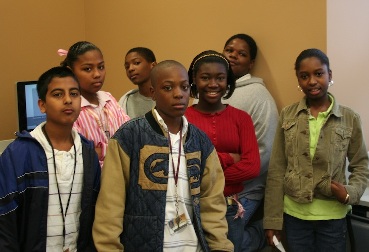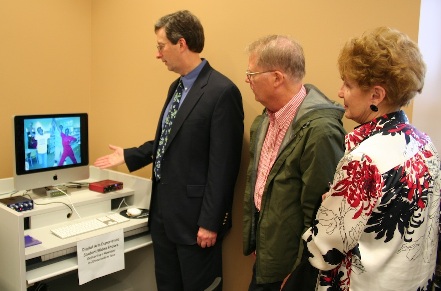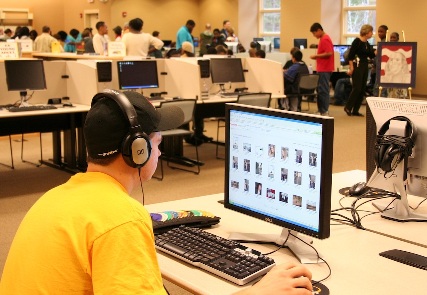
Some of the students who participated in the Carvers Bay Digital Arts Experience.
Purpose
The Carvers Bay Digital Arts Experience (DAE) is a unique collaboration by the Georgetown County Library System and the Cultural Council of Georgetown County, with funding from the Gaylord & Dorothy Donnelley Foundation and the Francis P. Bunnelle Foundation. The program is a fast-paced 12-week course designed to expose middle school students to the basic concepts and skills required to complete digitally oriented audiovisual projects. The students are encouraged to think for themselves as they work together in teams to concept, storyboard, shoot and edit their own video productions. Curriculum
The classes began by covering digital photography and slideshow development. For each class, the students spent one hour in lecture and demonstration and then checked out cameras to begin shooting images that would later be used into their slideshows. Once the images were taken, they were downloaded into iPhoto on Apple iMac computers and arranged and edited so that a simple story could be told in 3 to 5 final pictures. The students were able to add background music to their compositions. 
Students creating a soundtrack for their digital project.
I encouraged the students to come up with their own ideas for stories and to shoot what they felt would be appropriate. I was very pleased with the result and the enthusiasm with which the students took to this particular section of the course. They all showed care and concern with the quality of the work they were doing and with the final outcome of their projects. A few students went well beyond the scope of the project and experimented with additional retouching and rudimentary special effects. I made a special effort to point out the strongest points of each student's work both to build self-confidence and to encourage creative thinking across the entire group. As we moved forward, the students were taught basic procedures in the use of Garage Band to produce music and audio loops that they could use in the next project which was a video story to be concepted, shot and edited by the student teams. To begin this project the student were allowed to divide themselves into 4 teams and began the concept phase during which they sketched out their ideas on paper and began developing scripts. After producing the scripts, they were encouraged to develop rudimentary storyboards and shotlists to help keep their shooting organized. Some of the students were somewhat less than diligent in these two stages of the development and they learned first hand the importance of groundwork in a long-term project. Even so, all of the students produced projects that were, I believe, commensurate with their skill and emotional levels and I was quite pleased with the overall effort and the results. Result
All of the students who completed the course expressed interest in participating in a follow up course or courses that would allow them more in-depth pursuit of the digital techniques the learned in the DAE. They were very interested and many of them took time to explore the software and the techniques that were presented to them much more extensively than I had intended. I also found that as the course unfolded, many of the students began to assist and even teach other students as they moved forward with their projects. The DAE offers the students insight into a world that most of them will not see in their normal school courses and activities and presents the material in such a way that they feel more in control of what they are doing. By allowing the students to determine their own projects, in self-selected teams, they gain the confidence and the sense of personal value and respect that will, hopefully, encourage them to seek new solutions to the issues that they deal with on a day to day basis. Future
In considering the direction of the first session, one of the first things I did was cut the projects down from a series of small projects two one medium and one large project built up of smaller projects. This allowed the presentation of the material in a context that helped the students to see how the pieces of the puzzle fit together. For the next session, and in the development of the finalized DAE curriculum, I plan to incorporate the smaller of the two projects into the larger so the students are working on one project over the course of the program. The thematic guide is that I will be a client to the production teams and they will need to provide me with concepts for approval and then proceed through the normal, industry standard, stages of approval in the development of their video projects. This should help provide more structure to the development while at the same time providing me with better supervisory control and giving the students a better feel for real-world production and client concerns. With the anticipated addition of hardware I am expecting to have the teams work more efficiently and cover more ground in the overall production process. Conclusion
This interim summary is written for the purpose describing the successes and issues in presenting this fast-paced instruction as well as the overwhelmingly positive work completed by the students. It is also the intention of the author to invite response and suggestions that may be incorporated into future sessions of the DAE, as we've received additional grant funding to continue the DAE Project at the Carvers Bay Branch Library for at least another semester. 
Dwight McInVaill shows Barbara and Laurie Passmore a student's movie at the DAE Open House.
Statistics
- 25 Carvers Bay Middle School Students registered for these DAE public-library-based classes: that total included one student more than we'd planned to have. Due to limited resources, we couldn't include any more than that.
- Of these 25 initially-registered students, about 33% were in each of these grades: 6th grade (8 students); 7th grade (9 students); 8th grade (8 students). There were about the same number of boys as there were girls.
- 75% of those initially registered (or an average of 19 students out of 25) attended each session, with a high attendance of 24 students at session 3 and with a low attendance of 16 students at session 7. Eighteen students participated in the final active session on the Saturday preceding the Open House.
- 100% of the students who were present completed their projects each week.
- 68% of those initially registered students (or an average of 17 students out of 25 students) checked out library materials regularly each week, with a high of 21 youngsters checking out items on weeks 2 and 3, and with a low of 13 youngsters checking out items on week 1.
- $2,745 in Wal-Mart gift cards were awarded to these middle school students during the entire course of the DAE Project at a rate of $144 per active participant ($2,745 divided by 19 active students) or $14 per active student weekly. Youngsters received these rewards for attendance, for performance, and for checking out materials: $5 was given each time to reinforce each of these positive results (attendance, performance, and checking out materials) with the aim of developing and maintaining good habits in these young achievers.

Digital Arts Experience Open House.
Additional links:
Bryan Taylor is the instructor for the Carver's Bay DAE. Dwight McInvaill is the executive director of Georgetown County Library.
|




